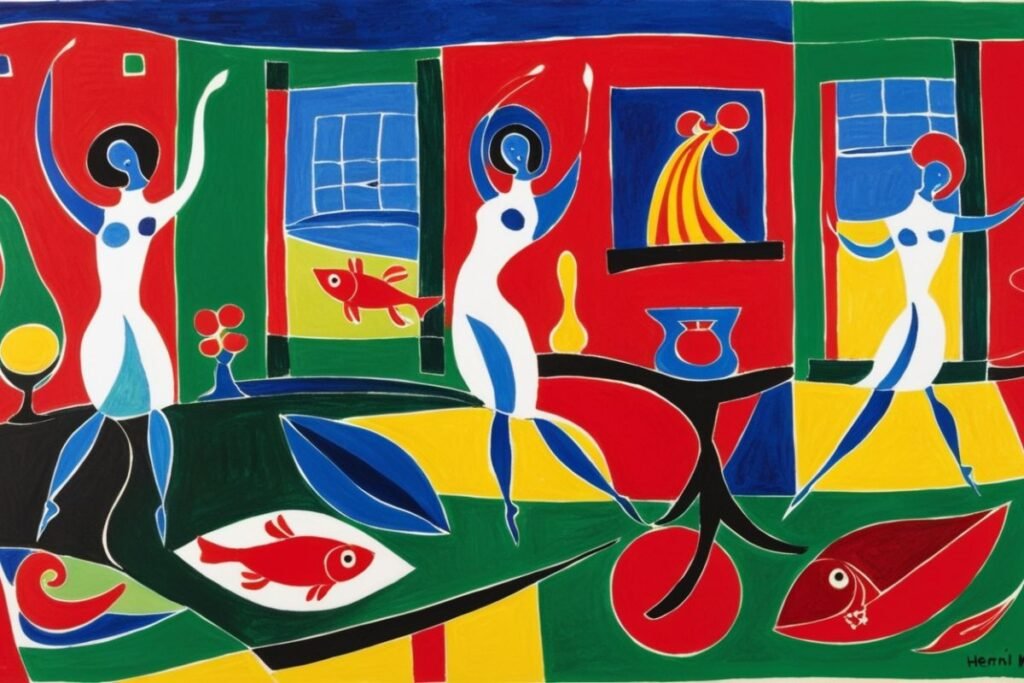Matisse Paintings. Henri Matisse, a pioneer of modern art, is celebrated for his extraordinary ability to convey emotion and joy through color and form. His innovative style has left an indelible mark on the art world, making Matisse paintings some of the most revered and recognizable works in art history. Here, we explore seven vibrant masterpieces that showcase his genius and his unwavering dedication to capturing the essence of life.
Table of Contents
1. The Dance (1910)
One of the most iconic Matisse paintings, The Dance represents vitality and movement through bold, simplified forms and vivid colors. The five dancing figures, rendered in striking red against a lush green and deep blue background, exude rhythm and energy. This painting encapsulates Matisse’s focus on harmony and his belief that art should evoke joy.
2. Woman with a Hat (1905)
This portrait of Matisse’s wife, Amélie, created a stir when it debuted. Its unconventional use of color—bright, almost unnatural hues applied with broad, expressive strokes—marked Matisse as a leader of the Fauvist movement. The boldness of Woman with a Hat exemplifies his departure from realism, emphasizing emotion over accuracy.
3. The Red Room (Harmony in Red) (1908)
The Red Room is a feast for the eyes, characterized by its brilliant use of red that envelops the entire canvas. This masterpiece exemplifies Matisse’s decorative approach, with flattened perspectives and intricate patterns that blur the line between foreground and background. It’s a vibrant representation of his vision of art as a source of pleasure.
4. Blue Nude II (1952)
Part of his later work, Blue Nude II reflects Matisse’s mastery of cut-out techniques. This artwork is a testament to his ability to innovate even in his later years when his physical condition limited his mobility. The simplicity of the form, achieved through cut paper, conveys elegance and depth, making it a standout among Matisse paintings.
5. Goldfish (1912)
Goldfish were a recurring motif in Matisse’s work, symbolizing tranquility and contemplation. In this painting, the fish become the focal point, surrounded by vibrant colors and lush vegetation. The peaceful imagery of Goldfish reflects Matisse’s pursuit of serenity and beauty in his art.
6. The Open Window (1905)
The Open Window is a quintessential example of Matisse’s Fauvist period, with its bold, vibrant colors and loose brushwork. Depicting a view from a window in Collioure, France, the painting radiates warmth and openness, inviting viewers to bask in the idyllic scene. It’s a masterpiece that celebrates life’s simple joys.
7. The Snail (1953)
One of the last major works by Matisse, The Snail is an abstract, vibrant composition created using his cut-out technique. The spiraling pattern of colorful shapes mimics the form of a snail shell, showcasing Matisse’s ability to distill complex ideas into simple, yet profound, forms.
The Legacy of Matisse Paintings
Henri Matisse’s contributions to art extend far beyond his vibrant canvases. He revolutionized how we perceive color and form, influencing countless artists across generations. Each of his masterpieces serves as a reminder of his belief that art should be a source of happiness and inspiration. Whether through bold Fauvist portraits or serene cut-outs, Matisse paintings continue to captivate audiences worldwide.
FAQs About Matisse Paintings
Q1: What style is Henri Matisse known for?
Matisse is most closely associated with Fauvism, characterized by bold colors and expressive brushwork, and his later cut-out technique.
Q2: Why are Matisse paintings significant?
Matisse revolutionized modern art by prioritizing emotion, color, and simplicity, making his works timeless and influential.
Q3: Where can I see Matisse paintings?
Many of Matisse’s works are displayed in renowned museums, such as the Museum of Modern Art (MoMA) in New York and the Centre Pompidou in Paris.
Q4: What materials did Matisse use in his later works?
In his later years, Matisse created art using paper cut-outs, a technique he called “painting with scissors.”


